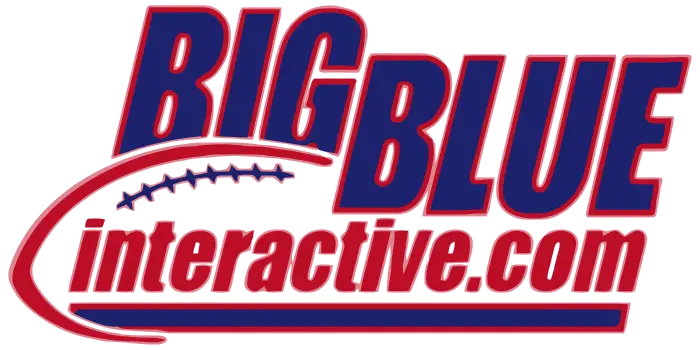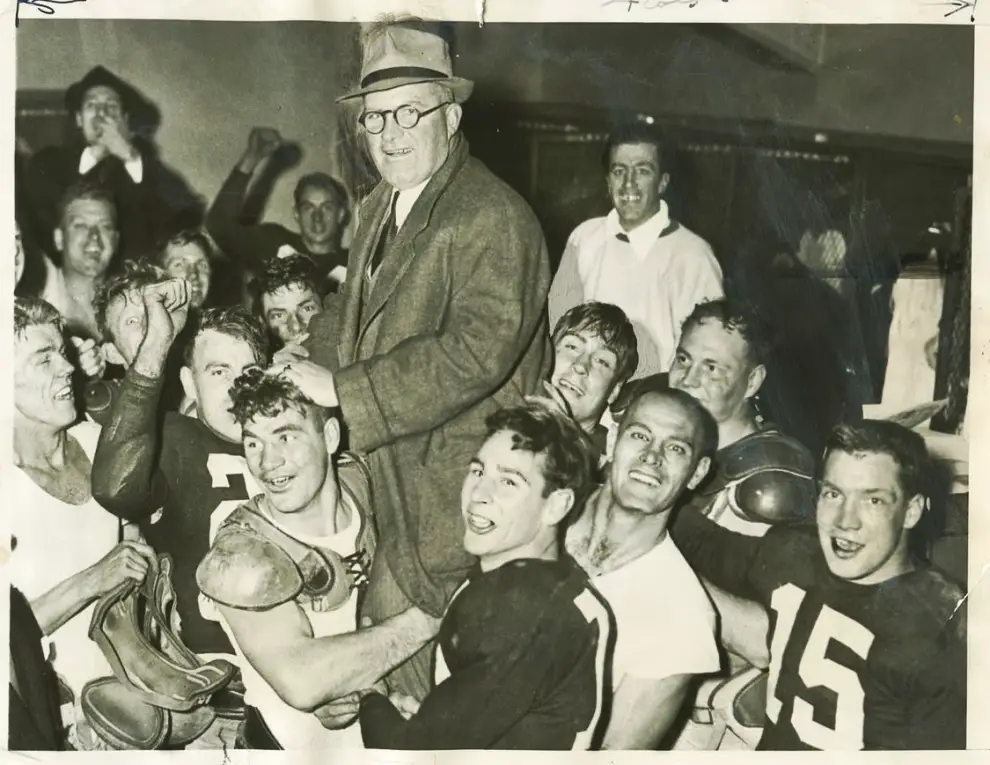The 1938 New York Giants
Anyone who watched NFL football during the 1980’s and 90’s is undoubtedly familiar with this phrase stated by John Madden, “Big players make big plays in big games.” Many of those “big players” would be later named to his All-Madden team the week prior to the Super Bowl, alongside some lesser known names who displayed characteristics that won the broadcaster over, like toughness, grit and heart. They were lunch-pail types who wore blood on their pants and their jerseys un-tucked. In December 1938 Madden was all of two years old, but there was a football team in New York with players fitting those descriptions, displaying all those attributes and more in the biggest game of the season.
The New Commodity
The quick-strike potential of throwing the football was starting to be realized by the mid 1930’s. Green Bay Packer founder Earl “Curly” Lambeau was one of the early proponents of the passing game, adding regimented passing drills into the team’s practices long before anyone else. His first great passer was Arnie Herber, who assumed the starting job in 1932 after serving as a back-up during the Packers championship seasons of 1930 and 1931. Herber led the NFL in passing yards and touchdowns in 1932 and 1934.
The catalyst for Green Bay’s quantum leap in the forward pass arrived in 1935. Don Hutson was the NFL’s first true wide receiver, and his arrival shook the NFL. On the first play of his first game, Hutson caught an 83-yard touchdown pass from Herber, which held up for a 7-0 victory against the Chicago Bears. The Herber-to-Hutson combination was as familiar to sports fans as Montana-to-Rice would be two generations later. The Green Bay passing game was so far ahead of its time, many of the standards Herber and Hutson set lasted 30 years or longer.
Although Hutson possessed good speed, it was the precision of his routes that enabled Lambeau to advance his concepts. Packer practices became a laboratory to experiment with route trees and the response of coverages. Herber loved throwing the long ball, when he and Hutson were in sync, defenses were rendered helpless. From his split wide position, Hutson lead the NFL in touchdown receptions every season from 1935 through 1938. In two of those seasons he also led the league in yards receiving. In 1936 Green Bay led the NFL in scoring and defeated the Boston Redskins in the championship game.
The Redskins relocated to Washington DC in 1937, and beat the Chicago Bears for the championship with a fourth-quarter-comeback by the NFL’s sensational rookie Sammy Baugh. Baugh was more than a great passer; he was a prodigy and became a star attraction for the league. As if to underscore his stature, the NFL created a new rule for the 1938 season: the personal foul for roughing-the-passer penalty was born.
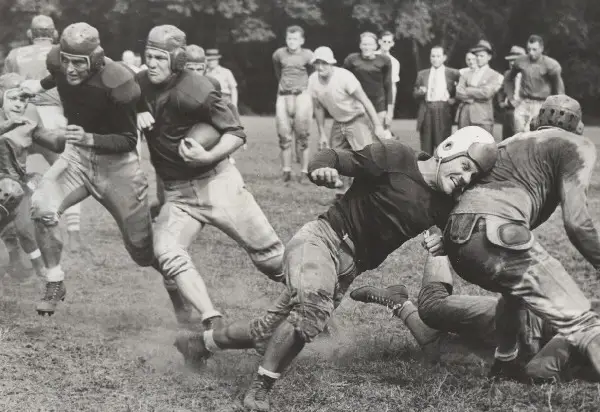
1938 New York Giants Training Camp, Hank Soar with the ball.
By 1938, the New York Giants rivalry with the Redskins was white hot. From the time the NFL split into two divisions in 1933 through 1946, the Giants and Redskins battled for the right to represent the Eastern Division in the championship game. The schedule makers took note, and even added a little fuel to the fire by routinely scheduling their meetings at the end of the year, often with the season finale at the Polo Grounds in front of huge crowds. The Giants won the East in 1933, ‘34, ‘35, ‘38, ‘39, ‘41, ‘44, ‘46 and the Redskins in 1936, ‘37, ‘40, ‘42, ‘43 (after a playoff with the Giants) and’45.
Old Indestructible
The New York Giants had a respectable offense in their own right. Ed Danowski led the league in passing yards for the 1935 season, but this was balanced by a powerful rushing attack featuring fullback Tuffy Leemans and halfback Hank Soar. The Giants real strength came from the one player Head coach Steve Owen built both sides of the ball around: Mel Hein.
Hein came to the NFL from Washington State in 1931 with no notoriety at all. It was five years before the first draft and scouting was still largely regional. The Pacific Northwest was a long way from the professional league, whose furthest outpost toward the Pacific Coast was Wisconsin. Hein took it upon himself to write letters of interest to three franchises: the Portsmouth Spartans, Providence Steam Rollers, and New York Giants. Providence offered him a contract for $125 per game and Hein accepted it. However, upon meeting with Giant end Ray Flaherty who told Hein the Giants would pay him $150 per game; Hein wired the post office in Providence to return the letter of acceptance to him so he could get the bigger contract.
Early in his rookie season, injuries to the Giants line necessitated Hein’s promotion to starter, and his iron-man streak of playing 60 minutes in 172 consecutive games began. It did not take long before the rangy Hein made an impression on even the most distinguished opponents. “Even as a rookie in 1931 there was no one like him,” said the Chicago Bears’ George Halas, “Usually you look for the rookies on another team and try to take advantage of them. We tried working on Hein, but from the beginning, he was too smart.” Hein matched his intelligence with grit. Bears tackle George Musso, who outweighed Hein in the vicinity of 40 pounds, gave Hein a blow to his unprotected nose after a snap. He cautioned Musso to knock it off, but the warning went unheeded. Hein said, “So on the following play, I was ready. I snapped the ball with one hand and got him with an uppercut square in the face. I could tell he really felt it. He never tried it again.”
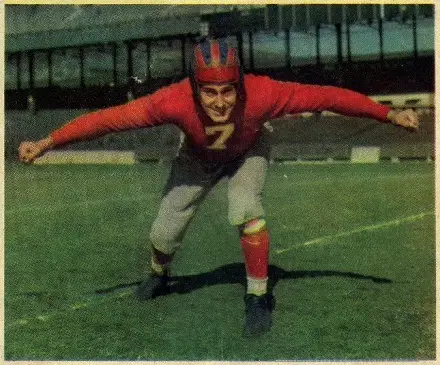
Mel Hein, New York Giants (1940)
Hein was the lynchpin in Owen’s versatile A-Formation, which featured the line strong to one side and the backs strong to the opposite side. The uncertainty to which position the snap was directed is what made it effective. Hein’s unerring accuracy was critical. An early admirer of his work was future Hall of Famer, Alex Wojciechowicz. While playing college football at Fordham as one of the famed Seven Blocks of Granite, Wojciechowicz would attend Giants games on Sundays for inspiration. “Hein was my idol,” Wojciechowicz said. “Sometimes there would be only 10,000 at a Giants game at the Polo Grounds after Fordham had outdrawn them by at least two to one, sometimes four to one, but I always went to the Giants games because I wanted to get all the pointers I could get and Mel Hein was my man.”
Many years later, another coaching legend offered his adulation: ”Hein developed techniques of snapping the ball and blocking that have been passed on from center to center ever since,” said George Allen, who regarded Hein as the NFL’s all-time best center.
On defense, Hein was equally impressive. Chicago Bear Bronko Nagurski recalled Hein as being “the surest, cleanest and most effective tackler” he’d ever faced. When he wasn’t delivering a bone jarring hit, Hein was dropping into coverage. He was one of the few players capable of staying with Hutson, and snared 17 career interceptions. Hein was named team captain in 1935, and served in that capacity until his retirement a decade later. In 1938, Hein led a defense that over 11 games surrendered just eight touchdowns and a league-low 79 points in total. Those efforts earned Hein the first Joe F. Carr Trophy as league MVP.
Owen instituted the unique two-platoon system in 1937, where he’d change out nearly complete units of 10 players at the end of the first and third quarters. The lone exception was Hein. “He was too good to take out,” the coach said. Hein never missed a game, and only called a time out once. In 1941 he suffered a broken nose in a game against the Bears. After receiving an adjustment he returned and finished the game.
Hein played 15 seasons for the Giants, a franchise mark matched only by Phil Simms and Michael Strahan. Long after Hein’s playing days had ended, Giants patriarch Wellington Mara reminisced on Hein’s importance. Mara said that Hein was the number one player of the Giants’ first 50 years, and that he was equaled only by Lawrence Taylor.
Even in his final campaign at the age of 36, Mel was still playing every game from the opening kickoff to the final gun. “I can’t prove this with any statistics,” Hein once said, “but I may have played more minutes than anybody in pro football history.” Owen said, “He played longer than any other Giant, and was coached less. Coaching him was like telling Babe Ruth how to hit.”
Oakland Raider founder Al Davis, who worked alongside Hein as assistant coaches at the University of Southern California in the 1950’s, said, “He was truly a football legend and a giant among men. Mel was one of the greatest football players who ever lived.”
The Irresistible Force versus the Immovable Object
Hein and his 1938 New York Giants found themselves atop the NFL Eastern Division in mid November with a 6-2 record. The most satisfying moment for New York thus far was a 10-7 revenge-laced victory at Washington in October (the Redskins had embarrassed the Giants 49-14 in the 1937 season finale at the Polo Grounds.) A quirk in the unbalanced schedule brought Green Bay to the Polo Grounds at 8-2. Their schedule had been uninterrupted, while the Giants had taken two bye weeks in September to accommodate their professional baseball co-tenants.
The Packers brimmed with confidence after defeating their two closest contenders in the Western Division, the Chicago Bears and Detroit Lions on the road. The game at Wrigley had been a tense, physical test of will, where the Green Bay defense rose to the occasion. The Packers led 21-17 at the half, and extended to a 24-17 lead in the third quarter. From there, the Packers stout defense held their ground with stand after stand, and kept Chicago off the scoreboard for the win. The final stats were unusually skewed against Green Bay. Chicago held significant advantages in first downs, 16-7, and total yards, 274-178. The 28-7 win at Detroit the following week was a costly one however; Hutson injured his knee and missed the game in New York.
Although still potent as ever on offense, Green Bay was in transition, personnel wise. Herber had shown signs of wear, so Lambeau implemented a tailback-by-committee system. Veterans Herber and Bob Monnett rotated with rookie sensation Cecil Isbell, and the results may have been better than ever. Hutson led the NFL in yards receiving and touchdowns yet again, and Isbell added a new dimension to the Packer attack. He led the team in both passing and rushing, as the Packers led the league in scoring, total yards and plays from scrimmage.
The Giants offense was effective, if somewhat more modest. The only category leaders for New York were halfback/kicker Ward Cuff in field goals and PATs, and tailback Ed Danowski with 70 pass completions. The latter, is somewhat misleading, however. Given that Green Bay’s trio of passers combined for 91 completions as a unit, and despite having the most completions, Danowski was just third in yardage. Defensively New York yielded the fewest points and yards, and while compiling the most interceptions.
The Giants needed that type of balance as they entered the second half of the contest of strengths against Green Bay deadlocked 0-0. Fittingly, the first points scored came on a safety for the Giants defense when full back Clarke Hinkle was tackled in his own end zone. The Packers regrouped, and took a 3-2 lead on a field goal. Green Bay’s offense found a rhythm, and moved the ball deep into Giants territory on their next possession, but missed a field goal attempt. On the Giants first play from scrimmage on the ensuing possession, Leemans slipped around right tackle, followed a block, then cut left and outran the secondary on a 75-yard touchdown gallop that brought the throng of 48,279 in the Polo Grounds to their feet. Green Bay controlled the ball the rest of the way, but the Giants defense put the game out of reach when Hein intercepted a pass and returned it 50 yards for a touchdown, sealing the crucial 15-3 victory.
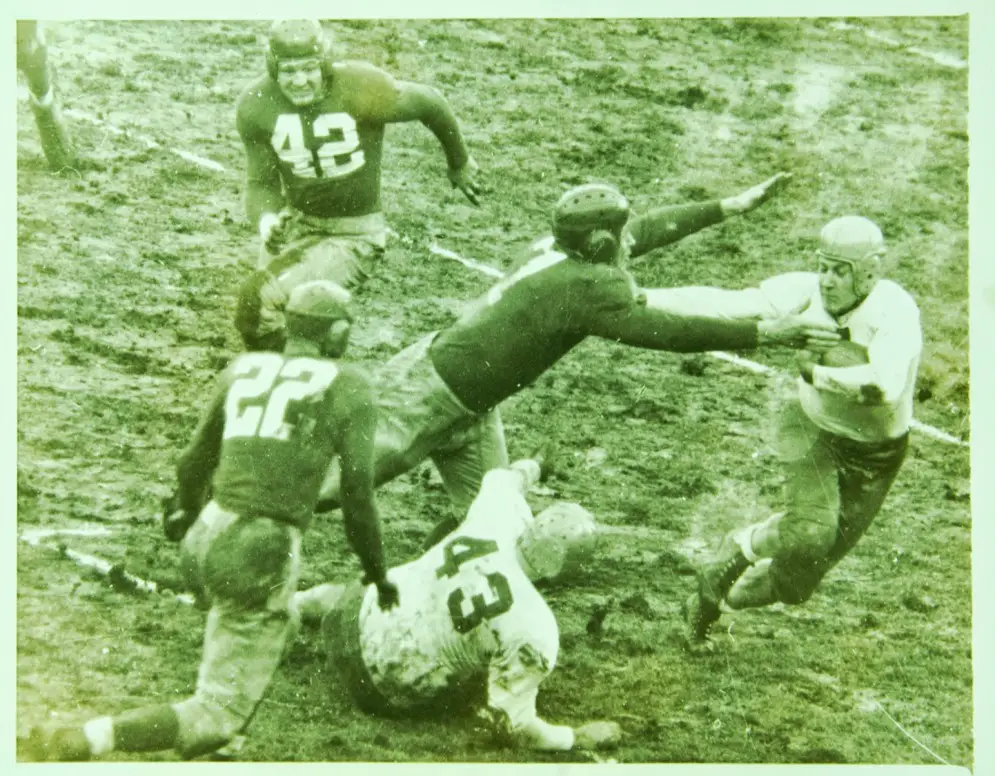
Green Bay Packers at New York Giants (November 20, 1938)
New York played their local rival Brooklyn Dodgers to a 7-7 tie on Thanksgiving four days later, which meant their final game against the Redskins would decide the Eastern Division title. One of the largest crowds to watch the Giants play to that date, 57,461 rowdy fans showed up in full vocal force to root their team on against Washington, and they were not disappointed. New York thoroughly romped the Redskins 36-0. Although the line score might give the impression the Redskins gave up late, the opposite was true. The more points the Giants scored against their feisty but error prone foe, the more physical and nasty the action became. Every pile became a scrum, with pushing and shoving after the whistle that put the officials under great strain to maintain order. After the teams retired to their respective locker-rooms, the Giants physical condition could easily have caused them to be mistaken as the team on the wrong end of the score. There was very little celebration taking place, as the Giants were, bruised, battered and exhausted. The training staff had their work cut out for them to get their players ready for the championship game.
The Last Men Standing
Aside from Hutson favoring his injured knee, Green Bay arrived in New York rested and ready. The Giants were another story entirely. All Pros Cuff and guard Johnny del Isola sat out of practice all week. Many of the Giants who were able work looked like walking wounded after a disaster, wrapped in assorted bandages and tape. Giants’ trainer Francis Sweeney said, “I don’t think I ever saw so tough a team. They were all determined to play, and if some of them had been private patients, I would have sent them to bed or the hospital.”
Two things the Giants had going for them were their running game and Hein’s unique skill set. Owen devised a defensive plan for the championship game that emphasized patience. The onus was on Hein, whose responsibility was to stay near the line of scrimmage after the snap, diagnose the play, then pursue and tackle the ball carrier.
The crowd of 48,120 was smaller than the turnout for the Redskin game the week prior, but was still big enough to be the largest to attend a title game to that point. The game started as the defensive standoff the Giants had hoped for. An exchange of punts pinned Green Bay on their 12-yard line. New York stuffed rushes on first and second down, and on third down the Packers elected to punt (a common strategy in precarious situations at that time.) Future Giant head coach Jim Lee Howell broke through the line and blocked Hinkle’s punt, which the Giants recovered inside the 10-yard line. Green Bay’s rugged defense held and the Giants settled for a Cuff field goal and a 3-0 lead.
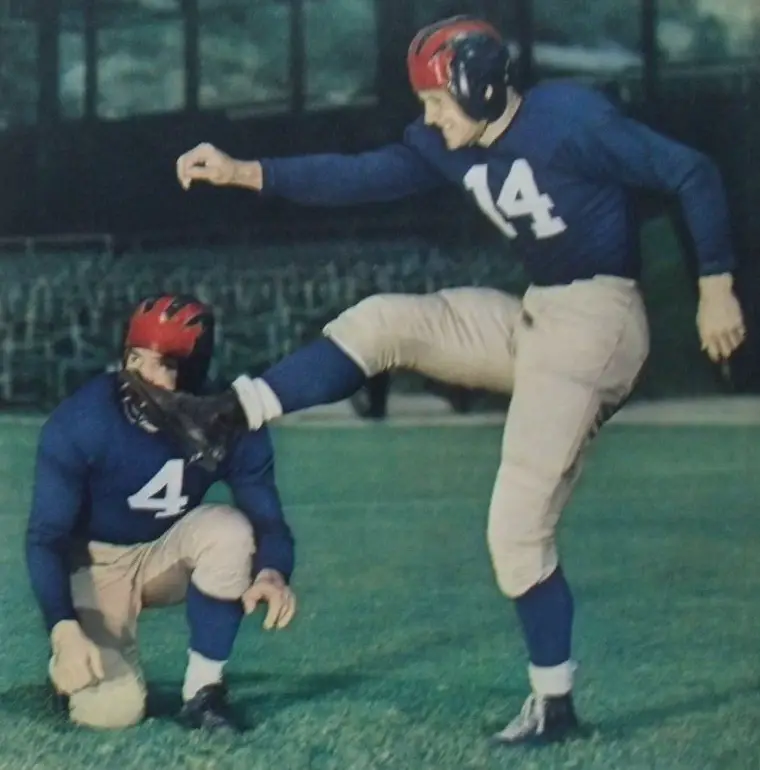
Tuffy Leemans (4) and Ward Cuff (14), New York Giants (1941)
Following the kickoff, New York’s defense held again and blocked another punt, this time Jim Poole deflected an Isbell attempt. Starting from the Packer 30 yard line, fullback Tuffy Leemans caught a Danowski pass then rushed three times before hitting pay dirt from nine-yards out on a counter play for a 9-0 lead. The score held when Johnny Gildea hooked the point after attempt wide left.
Another exchange of punts found the Packers pinned deep in their own end of the field again. Lambeau opted to punt on first down, and the Giants received the ball at mid field with a chance to take a surprising and commanding lead. Disaster struck for New York when Leeman’spass was intercepted by Tiny Engerbresten, giving Green Bay not only the ball in favorable field position, but a much needed reversal of momentum. The Packers took advantage quickly. After rushing for a first down, Herber connected on a 40-yard touchdown bomb to Carl Mulleneaux, trimming New York’s lead to 9-7.
Green Bay seized control of the game. They forced the Giants to punt then began another march that seemed destined to end with another touchdown until full back Ed Jankowski’s fumble was recovered by Hein. New York slugged its way back up the field, until Danowski capitalized with a 21-yard touchdown pass to Charles Barnard, ostensibly giving the Giants a comfortable 16-7 just before halftime. Green Bay had other ideas though. Wayland Becker caught a short pass underneath the Giants soft coverage and navigated his way to a 66-yard gain, stunning the Polo Grounds’ faithful. Hinkle capped the lightning-quick drive with a one-yard plunge for the touchdown.
Despite having a 16-14 lead after 30 minutes of play, Owen felt a sense of dread heading into the locker room. Hein, who uncharacteristically left the game for several moments in the second period after getting kicked in the head, reassured Owen, “It’s working coach. I give them the short stuff and Hutson doesn’t beat us.” Whether Owen took the pep talk from his captain to heart is questionable. Aside from seeing his team manhandled for most of the second quarter, the injury situation worsened as blocking back Lee Schaeffer exited the game with a broken leg.
The third quarter began with Green Bay receiving the kickoff without the gallant Hutson, who rested his aching knee on the bench. Regardless, the Packers continued their surge without their best player, driving into Giants territory and took the lead 17-16 with 15-yard Engerbresten field goal. Gildea was inconsolable on the New York sideline, “All I could think was that my missed kick was going to cost us the title.”
The Giants received the kick off and began from their own 38-yard line. Half back Hank Soar was the featured man, rushing four times on cutback runs against the Green Bay slanting defense for 19 yards. After a sack on Danowski, Soar received a pass that left New York with a 4th-and-1 on the Packer 44-yard line. Owen sensed this might be his exhausted team’s last opportunity for a score and elected to gamble. Soar knifed into the line and fell forward for a two-yard gain to covert, allowing the Giants drive to continue. Five plays later, Soar caught a pass between two defenders in front of the goal posts, and dragged Hinkle across the goal line for a 23-yard touchdown, regaining the lead 23-17. “I was near the goal line, and when I came down with the ball, I had three of four Packers all around me,” said Soar. “Clarke Hinkle grabbed me by one leg, but I pulled and pulled and jerked loose and went in.”
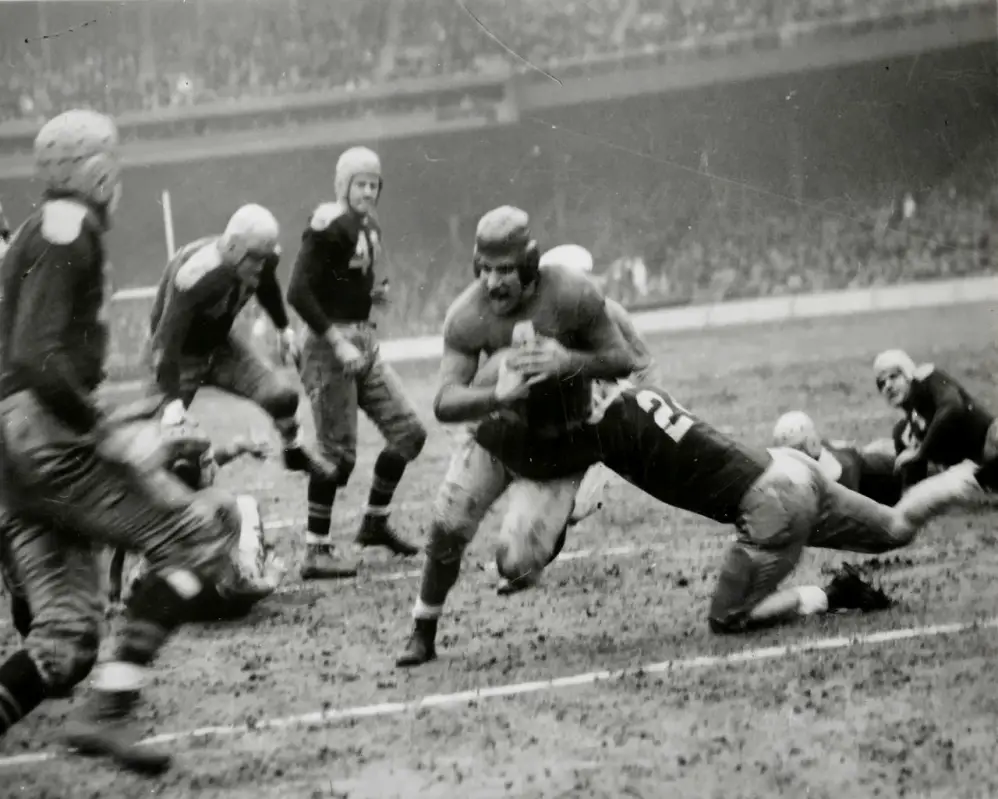
1938 NFL Championship Game, Green Bay Packers at New York Giants (December 11, 1938)
Having already abandoned his normally conservative philosophy, Owen scrapped his platoon system next. He chose his best (and healthiest) 11 players and put them on the field for the duration of the battle of attrition. Green Bay drove to the New York 33-yard line, but their scoring opportunity was thwarted when Danowski intercepted an Isbell pass. An exchange of punts spanned the expiration of the third quarter and left the Giants at their own two-yard line. Danowski punted on first down, but the Giants did not gain much as the play netted only 33 yards.
Hutson returned to the field, and on the first play Green Bay went for the kill, but Cuff broke up Herber’s bomb in the end zone. Following a short run, Herber threw for the end zone but the pass was defended again. On fourth down, Herber completed a pass for the first down, but Becker fumbled and New York recovered.
The Giants could not move the ball and punted again. Green Bay, however, lost possession on an ineligible receiver call. Herber completed a pass to Milt Ganterbein at the New York 40-yard line. However, Ganterbein was ruled ineligible after stepping up to the line of scrimmage, the penalty for which resulted in the Giants receiving possession at the previous line of scrimmage, Green Bay’s 43-yard line. Lambeau vehemently protested the call, but to no avail. The Packers followed that mistake by giving New York’s struggling offense a first down via penalty (their first since Soar’s touchdown catch). The Giants could not capitalize, and missed an opportunity to go ahead by two scores when Cuff’s 36-yard field goal attempt sailed wide.
Isbell took charge for the Packers on their ensuing possession. He passed and rushed the ball to the Giants 46 yard-line, but the New York defense held from there on downs. Soar picked up a rushing first down across the midfield stripe, but the Giants punted for a touchback with just over one minute left on the clock.
After a 16-yard scramble, Herber completed a pass to Mulleneaux, who lateraled to Hutson. With a seemingly clear path to the end zone, Soar caught Hutson from behind, 40 yards away from the end zone. Time remained for just one final play. Owen sent a blitz at Herber, who heaved the ball into the end zone where it fell to the ground incomplete. The Giants were finally able to exhale with the 23-17 lead finally secured.
Not all the Giants were available to celebrate the victory however. Del Isola and Cuff were transported to the hospital with possible fractured vertebrae and Hein for a concussion.
Many Giants gave heroic efforts with their performances; Soar was the most impressive on the stat sheet. His 106 total yards came largely in the second half, 65 yards rushing on 21 attempts and 41 yards on three receptions. He recollected years later, “After [the score giving the Giants the 23-17 lead], Ward Cuff kicked the point and Steve took me out of the game, and he said, ‘I want you to go back in again. You call the plays and don’t call anybody’s plays but your own. You carry the ball every goddamned time.’ Well, they hit me with everything except the stands, and that was because they couldn’t move the stands. It seemed like six years before the clock ran out. I think that game was the biggest thrill as far as football is concerned.”
All the writers covering the game agreed with New York’s hero of the moment. Superlatives reigned supreme in the Monday papers:
Arthur Daley of The New York Times: “The play for the full sixty vibrant minutes was absolutely ferocious. No such blocking and tackling by two football teams ever had been seen at the Polo Grounds. Tempers were so frayed and tattered that stray punches were tossed around all afternoon. This was the gridiron sport at its primitive best.”
Arthur Boer of The International News Service: “It was mostly a barroom fight outdoors. Close to 50,000 innocent bystanders looked upon the resumption of gang warfare in America. It was terrific.”
Jack Mahon of The New York Daily News: “In a story book game that had the crowd roaring from start to finish, the Giants struck fast, built up an early lead, lost it, and surged back through the gathering shadows for a sensational touchdown – and victory! No movie director could have staged a better thriller.”
Owen attributed the victory to his player’s grit and a few small changes in strategy. “They tore us apart and ran through us the other time [the 15-3 regular season meeting], but not this time. Those kids of mine just made up their minds that famous Packer attack was going to be stopped. And how they stopped it!” He also revealed that he had changed the blocking assignments and tendencies on offense, “Then, too, we didn’t throw as many passes as usual. When we found out early in the game we didn’t have to pitch ’em, well, we just didn’t.”
Those combined elements earned the Giants the distinction of becoming the first team to win two Championship Games, but their highest praise came years later from the man who fretted on the sidelines that day. After his retirement, Owen said the 1938 Giants were, “The finest group I ever coached.”
